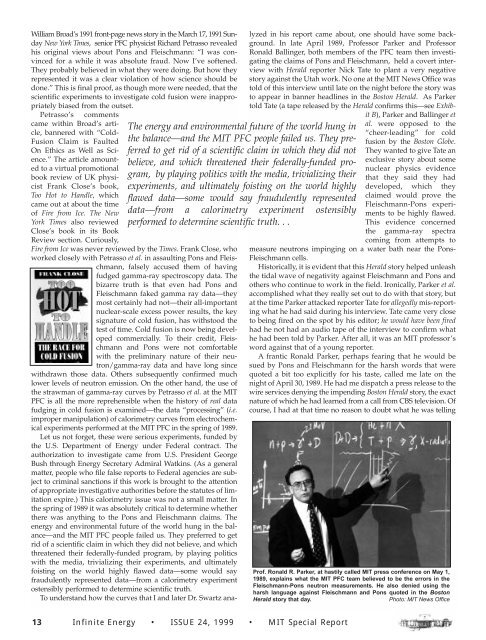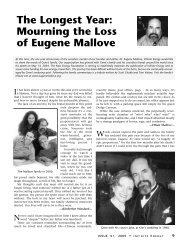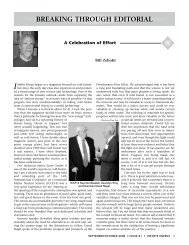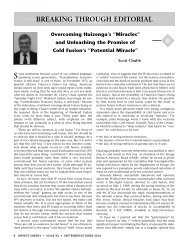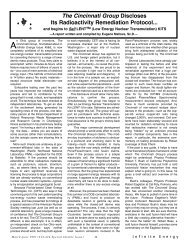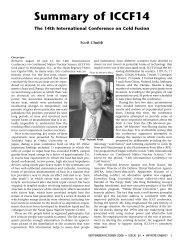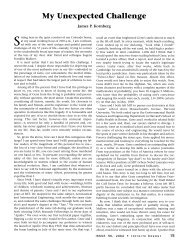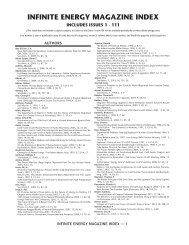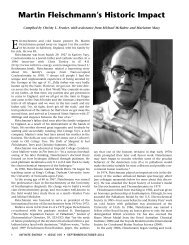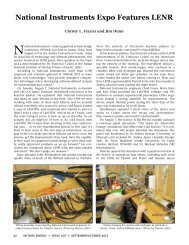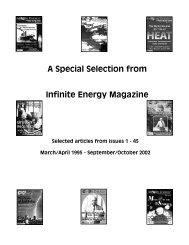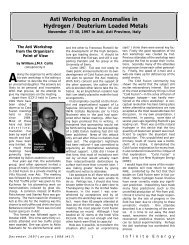MIT and Cold Fusion: A Special Report - Infinite Energy Magazine
MIT and Cold Fusion: A Special Report - Infinite Energy Magazine
MIT and Cold Fusion: A Special Report - Infinite Energy Magazine
Create successful ePaper yourself
Turn your PDF publications into a flip-book with our unique Google optimized e-Paper software.
William Broad’s 1991 front-page news story in the March 17, 1991 Sunday<br />
New York Times, senior PFC physicist Richard Petrasso revealed<br />
his original views about Pons <strong>and</strong> Fleischmann: “I was convinced<br />
for a while it was absolute fraud. Now I’ve softened.<br />
They probably believed in what they were doing. But how they<br />
represented it was a clear violation of how science should be<br />
done.” This is final proof, as though more were needed, that the<br />
scientific experiments to investigate cold fusion were inappropriately<br />
biased from the outset.<br />
Petrasso’s comments<br />
came within Broad’s article,<br />
bannered with “<strong>Cold</strong>-<br />
<strong>Fusion</strong> Claim is Faulted<br />
On Ethics as Well as Science.”<br />
The article amounted<br />
to a virtual promotional<br />
book review of UK physicist<br />
Frank Close’s book,<br />
Too Hot to H<strong>and</strong>le, which<br />
came out at about the time<br />
of Fire from Ice. The New<br />
York Times also reviewed<br />
Close’s book in its Book<br />
Review section. Curiously,<br />
Fire from Ice was never reviewed by the Times. Frank Close, who<br />
worked closely with Petrasso et al. in assaulting Pons <strong>and</strong> Fleischmann,<br />
falsely accused them of having<br />
fudged gamma-ray spectroscopy data. The<br />
bizarre truth is that even had Pons <strong>and</strong><br />
Fleischmann faked gamma ray data—they<br />
most certainly had not—their all-important<br />
nuclear-scale excess power results, the key<br />
signature of cold fusion, has withstood the<br />
test of time. <strong>Cold</strong> fusion is now being developed<br />
commercially. To their credit, Fleischmann<br />
<strong>and</strong> Pons were not comfortable<br />
with the preliminary nature of their neutron/gamma-ray<br />
data <strong>and</strong> have long since<br />
withdrawn those data. Others subsequently confirmed much<br />
lower levels of neutron emission. On the other h<strong>and</strong>, the use of<br />
the strawman of gamma-ray curves by Petrasso et al. at the <strong>MIT</strong><br />
PFC is all the more reprehensible when the history of real data<br />
fudging in cold fusion is examined—the data “processing” (i.e.<br />
improper manipulation) of calorimetry curves from electrochemical<br />
experiments performed at the <strong>MIT</strong> PFC in the spring of 1989.<br />
Let us not forget, these were serious experiments, funded by<br />
the U.S. Department of <strong>Energy</strong> under Federal contract. The<br />
authorization to investigate came from U.S. President George<br />
Bush through <strong>Energy</strong> Secretary Admiral Watkins. (As a general<br />
matter, people who file false reports to Federal agencies are subject<br />
to criminal sanctions if this work is brought to the attention<br />
of appropriate investigative authorities before the statutes of limitation<br />
expire.) This calorimetry issue was not a small matter. In<br />
the spring of 1989 it was absolutely critical to determine whether<br />
there was anything to the Pons <strong>and</strong> Fleischmann claims. The<br />
energy <strong>and</strong> environmental future of the world hung in the balance—<strong>and</strong><br />
the <strong>MIT</strong> PFC people failed us. They preferred to get<br />
rid of a scientific claim in which they did not believe, <strong>and</strong> which<br />
threatened their federally-funded program, by playing politics<br />
with the media, trivializing their experiments, <strong>and</strong> ultimately<br />
foisting on the world highly flawed data—some would say<br />
fraudulently represented data—from a calorimetry experiment<br />
ostensibly performed to determine scientific truth.<br />
To underst<strong>and</strong> how the curves that I <strong>and</strong> later Dr. Swartz analyzed<br />
in his report came about, one should have some background.<br />
In late April 1989, Professor Parker <strong>and</strong> Professor<br />
Ronald Ballinger, both members of the PFC team then investigating<br />
the claims of Pons <strong>and</strong> Fleischmann, held a covert interview<br />
with Herald reporter Nick Tate to plant a very negative<br />
story against the Utah work. No one at the <strong>MIT</strong> News Office was<br />
told of this interview until late on the night before the story was<br />
to appear in banner headlines in the Boston Herald. As Parker<br />
told Tate (a tape released by the Herald confirms this—see Exhibit<br />
B), Parker <strong>and</strong> Ballinger et<br />
al. were opposed to the<br />
“cheer-leading” for cold<br />
fusion by the Boston Globe.<br />
They wanted to give Tate an<br />
exclusive story about some<br />
nuclear physics evidence<br />
that they said they had<br />
developed, which they<br />
claimed would prove the<br />
Fleischmann-Pons experiments<br />
to be highly flawed.<br />
This evidence concerned<br />
the gamma-ray spectra<br />
coming from attempts to<br />
measure neutrons impinging on a water bath near the Pons-<br />
Fleischmann cells.<br />
Historically, it is evident that this Herald story helped unleash<br />
the tidal wave of negativity against Fleischmann <strong>and</strong> Pons <strong>and</strong><br />
others who continue to work in the field. Ironically, Parker et al.<br />
accomplished what they really set out to do with that story, but<br />
at the time Parker attacked reporter Tate for allegedly mis-reporting<br />
what he had said during his interview. Tate came very close<br />
to being fired on the spot by his editor; he would have been fired<br />
had he not had an audio tape of the interview to confirm what<br />
he had been told by Parker. After all, it was an <strong>MIT</strong> professor’s<br />
word against that of a young reporter.<br />
A frantic Ronald Parker, perhaps fearing that he would be<br />
sued by Pons <strong>and</strong> Fleischmann for the harsh words that were<br />
quoted a bit too explicitly for his taste, called me late on the<br />
night of April 30, 1989. He had me dispatch a press release to the<br />
wire services denying the impending Boston Herald story, the exact<br />
nature of which he had learned from a call from CBS television. Of<br />
course, I had at that time no reason to doubt what he was telling<br />
The energy <strong>and</strong> environmental future of the world hung in<br />
the balance—<strong>and</strong> the <strong>MIT</strong> PFC people failed us. They preferred<br />
to get rid of a scientific claim in which they did not<br />
believe, <strong>and</strong> which threatened their federally-funded program,<br />
by playing politics with the media, trivializing their<br />
experiments, <strong>and</strong> ultimately foisting on the world highly<br />
flawed data—some would say fraudulently represented<br />
data—from a calorimetry experiment ostensibly<br />
performed to determine scientific truth. . .<br />
Prof. Ronald R. Parker, at hastily called <strong>MIT</strong> press conference on May 1,<br />
1989, explains what the <strong>MIT</strong> PFC team believed to be the errors in the<br />
Fleischmann-Pons neutron measurements. He also denied using the<br />
harsh language against Fleischmann <strong>and</strong> Pons quoted in the Boston<br />
Herald story that day.<br />
Photo: <strong>MIT</strong> News Office<br />
13 <strong>Infinite</strong> <strong>Energy</strong> • ISSUE 24, 1999 • <strong>MIT</strong> <strong>Special</strong> <strong>Report</strong>


